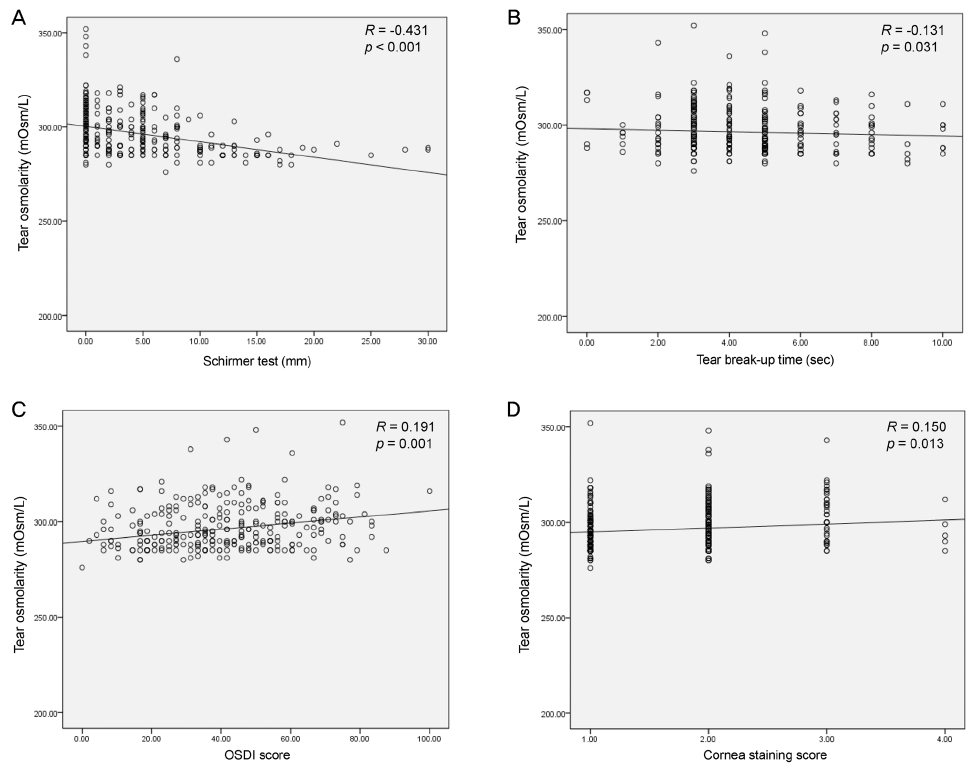J Korean Ophthalmol Soc.
2017 Jun;58(6):640-645. 10.3341/jkos.2017.58.6.640.
Clinical Significance of Tear Film Osmolarity for Non-Sjögren Dry Eye Diagnosis
- Affiliations
-
- 1Department of Ophthalmology, Incheon St. Mary's Hospital, College of Medicine, The Catholic University of Korea, Incheon, Korea.
- 2Department of Ophthalmology and Visual Science, Yeouido St. Mary's Hospital, College of Medicine, The Catholic University of Korea, Seoul, Korea. drna@catholic.ac.kr
- KMID: 2382671
- DOI: http://doi.org/10.3341/jkos.2017.58.6.640
Abstract
- PURPOSE
To evaluate the diagnostic value of tear film osmolarity for non-Sjogren dry eye syndrome through measuring the correlation between tear osmolarity and several conventional dry eye parameters.
METHODS
In this observational cross-sectional study, 274 patients (274 eyes) with non-Sjogren dry eye syndrome were examined using tear film osmolarity and the following conventional dry eye parameters: Schirmer's test, tear film break-up time, ocular surface disease index (OSDI), and corneal staining score. The correlations between tear film osmolarity and each conventional dry eye parameter were assessed using Spearman's correlation coefficients.
RESULTS
The mean tear film osmolarity of the study population was 296.34 ± 21.08 mOsm/L. The tear film osmolarity was significantly negatively correlated with the Schirmer's test value (r = -0.431, p < 0.001) and tear break-up time (r = -0.131, p = 0.031), while it was significantly positively correlated with the OSDI scores (r = 0.191, p = 0.001) and corneal staining scores (r = 0.150, p = 0.013).
CONCLUSIONS
Tear film instability was significantly correlated with other conventional dry eye parameters. However, additional studies are required to determine its feasibility as a stand-alone diagnostic tool.
Figure
Reference
-
1. The definition and classification of dry eye disease: report of the Definition and Classification Subcommittee of the International Dry Eye WorkShop (2007). Ocul Surf. 2007; 5:75–92.2. Kim WJ, Kim HS, Kim MS. Current trends in the recognition and treatment of dry eye: a survey of ophthalmologists. J Korean Ophthalmol Soc. 2007; 48:1614–1622.3. Bron AJ. Diagnosis of dry eye. Surv Ophthalmol. 2001; 45:Suppl 2. S221–S226.4. Methodologies to diagnose and monitor dry eye disease: report of the Diagnostic Methodology Subcommittee of the International Dry Eye WorkShop (2007). Ocul Surf. 2007; 5:108–152.5. Mishima S, Kubota Z, Farris RL. The tear flow dynamics in normal and in keratoconjunctivitis sicca cases. Excerpta Medica Int Congr Ser. 1970; 222:1801–1805.6. Schargus M, Wolf F, Tony HP, et al. Correlation between tear film osmolarity, dry eye disease, and rheumatoid arthritis. Cornea. 2014; 33:1257–1261.7. Amparo F, Jin Y, Hamrah P, et al. What is the value of incorporating tear osmolarity measurement in assessing patient response to therapy in dry eye disease? Am J Ophthalmol. 2014; 157:69–77.e2.8. Bunya VY, Langelier N, Chen S, et al. Tear osmolarity in Sjögren syndrome. Cornea. 2013; 32:922–927.9. Na KS, Yoo YS, Hwang KY, et al. Tear osmolarity and ocular surface parameters as diagnostic markers of ocular Graft-Versus-Host Disease. Am J Ophthalmol. 2015; 160:143–149.e1.10. Gilbard JP. Tear film osmolarity and keratoconjunctivitis sicca. CLAO J. 1985; 11:243–250.11. Bron AJ, Evans VE, Smith JA. Grading of corneal and conjunctival staining in the context of other dry eye tests. Cornea. 2003; 22:640–650.12. Tomlinson A, Khanal S. Assessment of tear film dynamics: quantification approach. Ocul Surf. 2005; 3:81–95.13. Bron AJ, Tiffany JM, Yokoi N, Gouveia SM. Using osmolarity to diagnose dry eye: a compartmental hypothesis and review of our assumptions. Adv Exp Med Biol. 2002; 506(Pt B):1087–1095.14. Suzuki M, Massingale ML, Ye F, et al. Tear osmolarity as a biomarker for dry eye disease severity. Invest Ophthalmol Vis Sci. 2010; 51:4557–4561.15. Lemp MA, Bron AJ, Baudouin C, et al. Tear osmolarity in the diagnosis and management of dry eye disease. Am J Ophthalmol. 2011; 151:792–798.e1.16. Tomlinson A, Khanal S, Ramaesh K, et al. Tear film osmolarity: determination of a referent for dry eye diagnosis. Invest Ophthalmol Vis Sci. 2006; 47:4309–4315.17. Versura P, Profazio V, Campos EC. Performance of tear osmolarity compared to previous diagnostic tests for dry eye diseases. Curr Eye Res. 2010; 35:553–564.
- Full Text Links
- Actions
-
Cited
- CITED
-
- Close
- Share
- Similar articles
-
- Correlation between Tear Osmolarity and Other Ocular Surface Parameters in Primary Sjögren's Syndrome
- Correlations between Tear Osmolarity and Ocular and Systemic Parameters in Primary Sjögren's Syndrome
- Clinical Significance of Tear Film Osmolarity in Patients with Mild Dry Eye Syndrome
- Ocular Manifestations of Sjögren Syndrome
- The significance of tear film break-up time in the diagnosis of dry eye syndrome


